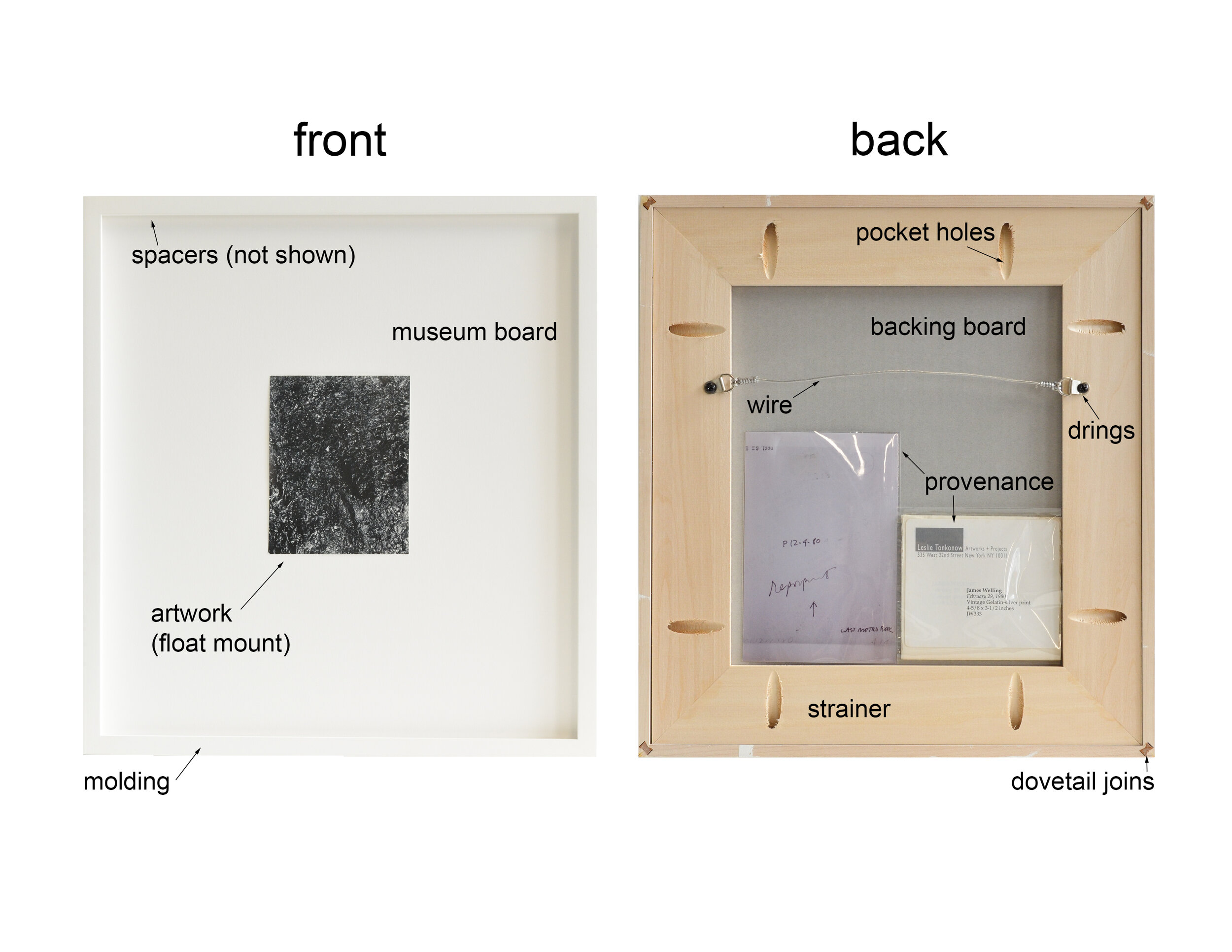Every industry has its own specific terminology and so does framing! This quick post breaks down the basics about the parts and pieces of a frame and the vocab helpful to know when talking about your next project.
A General Glossary of Framing Terminology
Acid-free - A misnomer, unfortunately in common use. Acid free basically means it is PH neutral and is not the same as archival or museum quality.
Allowance - the ‘wiggle room’ factored into the frame size. Common allowance is 1/16”, meaning that the mat dimensions will be 1/16” less than the actual frame opening.
Archival - a general term referring to museum quality methods and materials. All archival practices should be completely reversible!
Backing board - The most outward barrier in the back of the frame. Common backing board materials are coroplast (corrugated plastic) , ph neutral blue board, and acid free foamboard.
Book - Taping the front and the back mat together, usually with Tyvek tape or linen tape. When together, it resembles a book, hence the term.
Bottom weight - when designing the border widths of the matting it is customary to make the bottom border slightly larger. This gives a proper “weight” to the design.
Conservation - is the study of the physical care and treatment of photographic materials. While preservation framing and conservation have many common techniques, conservation requires an in-depth understanding of how photographs are made, and the causes and prevention of deterioration. Conservator-restorers use this knowledge to treat photographic materials, stabilizing them from further deterioration, and sometimes restoring them for aesthetic purposes.
Corner - a method of keeping artwork in place by using pH neutral cotton rag paper to make small triangles. Corners are adhered to the back mat using tyvek tape, linen tape, or Filmoplast.
Engage - a window reveal style that comes very slightly into the image, usually 1/16” or less. This is the simplest and most straightforward window style.
Dibond - a mounting substrate made of plastic layers sandwiched between aluminum layers stays completely flat and will not warp.
Face width - the width of the face of the frame as you stand in front of the work.
Float mount - an artwork reveal style that shows all edges of the artwork. Float mounts do not include top mats.
Frame depth - the outside dimension of the of the frame from the front to the back.
Frame size - the same as the inside frame size. Refers to the opening of the frame (excluding allowance), not the outside dimensions of the frame.
Glazing - the clear protective material between the artwork and the rest of the world. Common glazing materials are plexiglass and glass. Name brands include Art Glass, Optium, UV OP3, Museum Glass, etc.
Hardware - all metal parts involved in the structural support of hanging the frame. Common hanging hardware includes d-rings, wire, and metal cleats.
Hinge - rectangular pieces of torn rice paper. They act as a flexible method of attachment that allows the artwork to expand and contract with environmental changes. Hinges are attached using wheat paste glue, mixed fresh each day with distilled water.
Inside frame size - the dimensions of the materials going inside of the frame. The inside frame size differs slightly (1/16 less) from the actual frame opening. For example, a common inside frame size 16” x 20”, although the actual frame opening will measure 16 1/16” x 20 1/16”.
Molding - the term used for the wood of the frame.
Mounting - Refers to a procedure where a print is completely affixed to a substrate. Common types of mounting are pressure sensitive mounting, vacuum seal mounting, hot press mounting, and wet mounting. Common substrates are museum board, sintra, and dibond and plexi. Large works and contemporary photos are commonly mounted. Mounting always contains inherent risk.
Museum board - 100% rag mat boards, always pH neutral. Standard thicknesses are 4ply and 8ply,
Museum quality - something made with high quality materials or techniques. Basically, a cut above the rest. The term means a level of protection or preservation used in the framing process.
Profile - the shape of the molding, frame shape.
Raised float mount - A framing style where the artwork is raised up and then floated. For drawings and other small works, a common raised float mount depth is ⅛”, made using 8ply. For larger mounted works on dibond or sintra, it is common to do a raised float mount by adhering an inside wood or metal brace.
Sight size - the dimension from frame opening from the front inside to inside width and height.
Sintra - a mounting substrate, originally from the sign industry. Made of plastic, it’s a cheaper alternative to dibond.
Spacer - the thin strip of material, usually matboard or wood, that separates the glazing from the artwork. Spacers are usually used in frames with floated artwork, although sometimes will be added to frames with mats for aesthetic reasons.
Strainer - the wooden frame support in the back of a frame. Most commonly used in thin faced frames that require extra structural integrity.
Window size - the opening in the mat that reveals the artwork below.
White space - a window reveal style, showing the white of the paper beyond the image, usually measuring anywhere from 1/16” - ½” all around.

